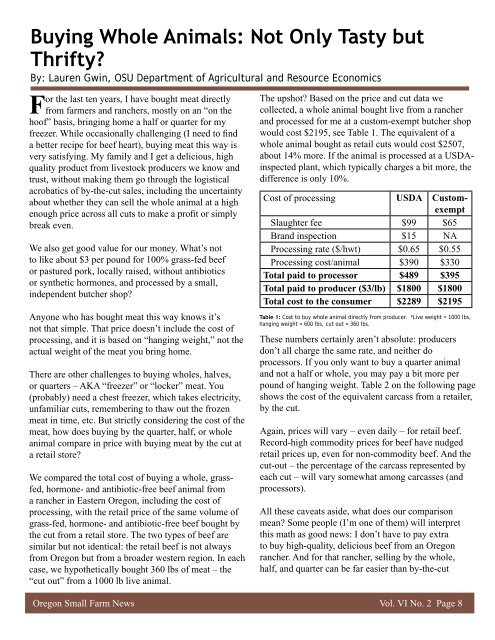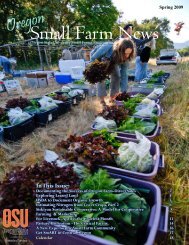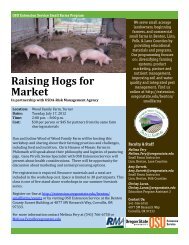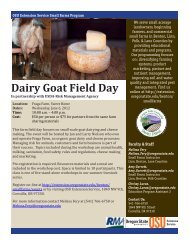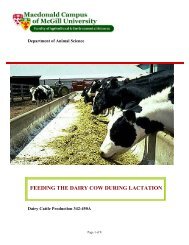Small Farm News - Oregon Small Farms - Oregon State University
Small Farm News - Oregon Small Farms - Oregon State University
Small Farm News - Oregon Small Farms - Oregon State University
Create successful ePaper yourself
Turn your PDF publications into a flip-book with our unique Google optimized e-Paper software.
Buying Whole Animals: Not Only Tasty butThrifty?By: Lauren Gwin, OSU Department of Agricultural and Resource EconomicsFor the last ten years, I have bought meat directlyfrom farmers and ranchers, mostly on an “on thehoof” basis, bringing home a half or quarter for myfreezer. While occasionally challenging (I need to finda better recipe for beef heart), buying meat this way isvery satisfying. My family and I get a delicious, highquality product from livestock producers we know andtrust, without making them go through the logisticalacrobatics of by-the-cut sales, including the uncertaintyabout whether they can sell the whole animal at a highenough price across all cuts to make a profit or simplybreak even.We also get good value for our money. What’s notto like about $3 per pound for 100% grass-fed beefor pastured pork, locally raised, without antibioticsor synthetic hormones, and processed by a small,independent butcher shop?Anyone who has bought meat this way knows it’snot that simple. That price doesn’t include the cost ofprocessing, and it is based on “hanging weight,” not theactual weight of the meat you bring home.There are other challenges to buying wholes, halves,or quarters – AKA “freezer” or “locker” meat. You(probably) need a chest freezer, which takes electricity,unfamiliar cuts, remembering to thaw out the frozenmeat in time, etc. But strictly considering the cost of themeat, how does buying by the quarter, half, or wholeanimal compare in price with buying meat by the cut ata retail store?We compared the total cost of buying a whole, grassfed,hormone- and antibiotic-free beef animal froma rancher in Eastern <strong>Oregon</strong>, including the cost ofprocessing, with the retail price of the same volume ofgrass-fed, hormone- and antibiotic-free beef bought bythe cut from a retail store. The two types of beef aresimilar but not identical: the retail beef is not alwaysfrom <strong>Oregon</strong> but from a broader western region. In eachcase, we hypothetically bought 360 lbs of meat – the“cut out” from a 1000 lb live animal.The upshot? Based on the price and cut data wecollected, a whole animal bought live from a rancherand processed for me at a custom-exempt butcher shopwould cost $2195, see Table 1. The equivalent of awhole animal bought as retail cuts would cost $2507,about 14% more. If the animal is processed at a USDAinspectedplant, which typically charges a bit more, thedifference is only 10%.Cost of processing USDA CustomexemptSlaughter fee $99 $65Brand inspection $15 NAProcessing rate ($/hwt) $0.65 $0.55Processing cost/animal $390 $330Total paid to processor $489 $395Total paid to producer ($3/lb) $1800 $1800Total cost to the consumer $2289 $2195Table 1: Cost to buy whole animal directly from producer. *Live weight = 1000 lbs,hanging weight = 600 lbs, cut out = 360 lbs.These numbers certainly aren’t absolute: producersdon’t all charge the same rate, and neither doprocessors. If you only want to buy a quarter animaland not a half or whole, you may pay a bit more perpound of hanging weight. Table 2 on the following pageshows the cost of the equivalent carcass from a retailer,by the cut.Again, prices will vary – even daily – for retail beef.Record-high commodity prices for beef have nudgedretail prices up, even for non-commodity beef. And thecut-out – the percentage of the carcass represented byeach cut – will vary somewhat among carcasses (andprocessors).All these caveats aside, what does our comparisonmean? Some people (I’m one of them) will interpretthis math as good news: I don’t have to pay extrato buy high-quality, delicious beef from an <strong>Oregon</strong>rancher. And for that rancher, selling by the whole,half, and quarter can be far easier than by-the-cut<strong>Oregon</strong> <strong>Small</strong> <strong>Farm</strong> <strong>News</strong> Vol. VI No. 2 Page 8


